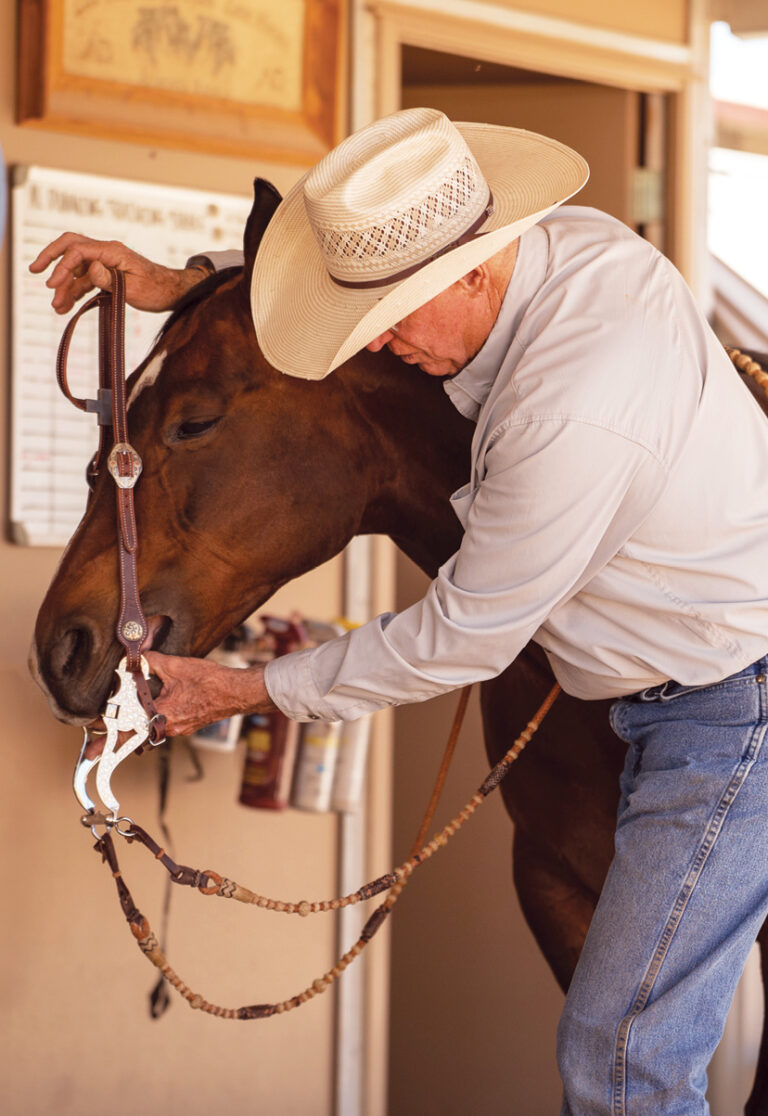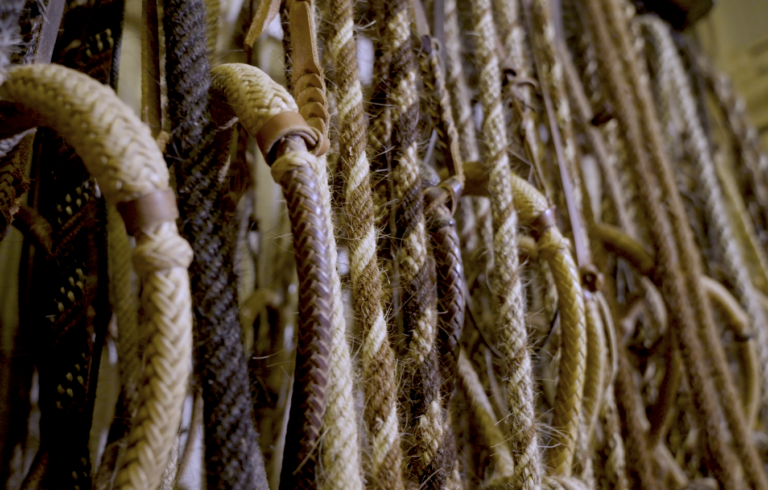A halter allows you to hold onto and direct your horse. The strongest halter is good halter training.? After all, to control your trail horse, you need his cooperation. Halter pressure is merely a cue.
When you lead your horse, he feels pressure on the sensitive area behind his ears. It’s as though the crownpiece pushes his head forward when you pull the lead rope forward.
Halters range from mild to severe. When the halter material is wide, it’s like the flat of someone’s hand. But if the halter is sharp or narrow, the pressure is concentrated. It’s like poking him with a fingernail ? or worse.
Assuming correct fit, any halter should feel comfortable to your horse when it’s just lying on his head. So choosing a halter isn’t only a matter of style. How you use it matters.
Train with Care
A well-trained horse understands what you want him to do with very little guidance. You can use nearly any style of halter, because you’re not likely to apply severe pressure.
But if your horse hasn’t learned to give to pressure, you have to be careful that the halter doesn’t hurt or scare him, and actually cause him to react.
It’s natural to meet pressure with pressure. When your horse feels halter pressure, he instinctively presses into the pressure, as if to push it away. When a small effort doesn’t do it, he usually pushes harder, sometimes to the point of running backward.
You want your horse to move his head forward or down in response to the pressure. But that’s a learned response. So how do you teach it? There are two approaches:
- Light pressure training. One approach is to put light pressure on the halter?just enough that the horse moves his head but not so much pressure that he feels he has to pull back. He’ll think for a moment about how to get that pressure to go away, and he’ll try options. One of the options is to move his head down or forward, at which point you release the halter and praise him. He won’t have gotten upset. He hasn’t had to do the wrong thing first, and he’s been rewarded for guessing correctly. With repetition, the response becomes automatic.
- More severe pressure. With a harsher halter, sometimes called a training halter, the horse is essentially punished when he makes a bad choice, because pulling back is really uncomfortable and sometimes painful. A skillful trainer can use pressure on the halter to essentially tell the horse, “Don’t go there.” The trainer can release the pressure in time, preventing the horse from slamming against it.
However, more severe halters can become abusive in the hands of an inexperienced or insensitive handler. And there’s a greater chance the horse will panic or become injured with a more severe halter than a milder one.
Regardless of which system you’re working with, a horse should never be tied until he’s learned to give to pressure and been thoroughly tested in exciting situations.
Choose Your Halter
With a better understanding of how halters work, here’s the selection of halters available. The three major categories are rope, web, and leather.
Leather Halters
Leather halters are the traditional show or stable halter, and they look classy. They’re available in various thicknesses, from the most refined, rolled English bridle leather to the more rugged harness leather for turnout halters.
Leather requires occasional care to avoid drying out or cracking. Once the leather has cracked, it has lost integrity and is likely to break, so you should discard it.
Web Halters
Web halters come in a wide variety of sizes, materials, fit, and options. You’ll find adjustable nosebands, hardware options, and lots of color choices.
Generally speaking, the more layers of webbing, the sturdier the halter is. Avoid inexpensive single-ply (one layer) halters, as the material gets stiff and rough quicker, and they usually have poorer quality hardware.
It’s worth it to pay more for solid, easy-to-operate hardware, such as brass or nickel-plated brass. It won’t rust and will last longer than cheap hardware.
Rope Halters
Rope halters are usually made from one long rope and tied with various knots ? no hardware. Many halters have a lead rope tied on, since there’s no hardware to clip to.
You can adjust the halter to fit the shape and size of your horse’s head by retying the knots, especially when the halter is new. Once it’s been worn for a while, the knots generally tighten and are harder to adjust.
Rope halters come in various thicknesses and stiffness of rope. The thinner the rope, the more it’ll bite into your horse when under pressure.
Softer ropes lie against your horse’s head, but are a little more difficult to put on since the rope hangs limp. Stiffer rope halters hold their shape, and offer a clearer signal during ground work.
Some rope halters have knots placed in the noseband in addition to those at the junction of the cheek and noseband. These knots apply pressure to the horse’s tender nose cartilage for training purposes, and should only be used by skilled handlers.
Maureen Gallatin is a writer, speaker, and consultant. She teaches frequently on the topic of developing confidence. She’s known for her brand of practical wisdom and insights with an inspirational bent. She’s the founder of Inspired By Horses, an equine-oriented, nondenominational Christian project.




